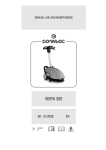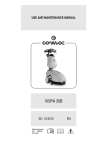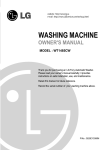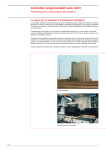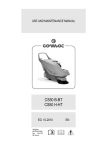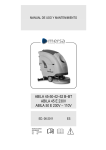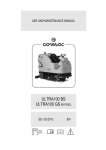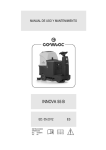Download Vispa 35BS
Transcript
USE AND MAINTENANCE MANUAL VISPA 35BS ED. 09-2010 ORIGINAL INSTRUCTIONS Doc. 10020820 Ver. AB EN The descriptions contained in this document are not binding. The company therefore reserves the right to make any modifications at any time to elements, details, or the supply of accessories, as considered necessary for reasons of improvement or manufacturing/commercial requirements. The reproduction, even partial, of the text and drawings contained in this document is prohibited by law. The company reserves the right to make any technical and/or supply modifications. The images are for reference purposes only, and are not binding in terms of design and supply. Symbols used in the manual Open book symbol with an "i" Indicates the need to consult the instruction manual Open book symbol Used to tell the operator to read the manual before using the machine Warning symbol Carefully read the sections marked with this symbol and observe the indications, for the safety of the operator and the machine Warning symbol Indicates danger of gas fumes and the leakage of corrosive liquids Warning symbol Danger of fire: do not go near with free flames Disposal symbol Carefully read the sections marked with this symbol for machine disposal CONTENTS ON CONSIGNMENT OF THE MACHINE .................................................................................................................................................. 4 SERIAL NUMBER PLATE..................................................................................................................................................................... 4 INTRODUCTORY COMMENT ................................................................................................................................................................ 4 INTENDED USE.................................................................................................................................................................................. 4 TECHNICAL DESCRIPTION .................................................................................................................................................................. 5 SYMBOLS USED ON THE MACHINE...................................................................................................................................................... 6 GENERAL SAFETY REGULATIONS....................................................................................................................................................... 7 MACHINE PREPARATION.................................................................................................................................................................... 8 1. HANDLING THE PACKED MACHINE........................................................................................................................................... 8 2. HOW TO UNPACK THE MACHINE.............................................................................................................................................. 8 3. HANDLING AND TRANSPORTATION OF THE UNPACKED MACHINE............................................................................................... 8 4. TYPE OF BATTERY ................................................................................................................................................................. 9 5. BATTERY MAINTENANCE AND DISPOSAL.................................................................................................................................. 9 6. INSERTING/CONNECTING THE BATTERIES...............................................................................................................................9 7. CONNECTING THE CONNECTOR............................................................................................................................................ 10 8. RECHARGING THE BATTERIES .............................................................................................................................................. 10 9. BATTERY INDICATOR ........................................................................................................................................................... 12 10. INSTRUMENT PANEL COMPONENTS.................................................................................................................................. 12 11. ASSEMBLING THE BRUSHES ............................................................................................................................................. 12 12. FIXING THE HANDLEBARS................................................................................................................................................. 13 13. SOLUTION TANK .............................................................................................................................................................. 13 14. DETERGENT SOLUTION .................................................................................................................................................... 13 15. RECOVERY TANK............................................................................................................................................................. 14 WORK ............................................................................................................................................................................................ 15 1.PREPARING TO WORK ............................................................................................................................................................... 15 2.OVERFLOW DEVICE................................................................................................................................................................... 16 3.FORWARD MOVEMENTS ............................................................................................................................................................ 16 AT THE END OF THE WORK............................................................................................................................................................... 17 DAILY MAINTENANCE ....................................................................................................................................................................... 18 1. CLEANING THE RECOVERY TANK ............................................................................................................................................... 18 2.CLEANING THE FRONT AND REAR SQUEEGEES............................................................................................................................ 18 3.CLEANING THE DEBRIS HOPPER................................................................................................................................................. 18 4. DISASSEMBLING THE BRUSH .................................................................................................................................................... 19 WEEKLY MAINTENANCE................................................................................................................................................................... 20 1.REPLACING THE REAR SQUEEGEE RUBBERS .............................................................................................................................. 20 2.REPLACING THE FRONT SQUEEGEE RUBBERS............................................................................................................................. 20 3.CLEANING THE SQUEEGEE TUBE................................................................................................................................................ 21 4.CLEANING THE SOLUTION TANK AND FILTER ...............................................................................................................................21 TROUBLESHOOTING........................................................................................................................................................................ 22 1.ELECTRICAL SYSTEM SAFETY .................................................................................................................................................... 22 2.INSUFFICIENT WATER ON THE BRUSHES..................................................................................................................................... 22 3.THE MACHINE DOES NOT CLEAN WELL........................................................................................................................................ 22 4.THE SQUEEGEE DOES NOT DRY PERFECTLY ...............................................................................................................................22 5.EXCESSIVE FOAM PRODUCTION ................................................................................................................................................. 22 CHOOSING AND USING THE BRUSHES............................................................................................................................................... 23 MACHINEDISPOSAL ......................................................................................................................................................................... 24 EC DECLARATION OF CONFORMITY .................................................................................................................................................. 25 3 On consignment of the machine Serial number plate When the machine is delivered to the customer, an immediate check must be performed to ensure all the material mentioned in the shipping documents has been received, and also to check the machine has not been damaged during transportation. If this is the case, the carrier must ascertain the extent of the damage at once, informing our customer service office. It is only by prompt action of this type that the missing material can be obtained, and compensation for damage successfully claimed. Introductory comment VISPA 35BS is a scrubbing machine which / by means of the mechanical action of the cylindrical brushes and the chemical action of a waterdetergent solution - can clean any type of floor. In addition, as it moves forward it picks up removed dirt and the detergent solution not absorbed by the floor. The machine must be used only for this purpose. Even the best machines will only work well if used correctly and kept in good working order. We therefore suggest you read this instruction booklet carefully and read it again whenever difficulties arise while using the machine. If necessary, remember that our assistance service (organised in collaboration with our dealers) is always available for advice or direct intervention. Intended use The scrubbing machine is designed exclusively for the professional cleaning of surfaces and floors in industrial, commercial and public environments. The machine is only suitable for use in closed (or at least covered) places. The machine is not suitable for use in the rain, or under water jets. It is FORBIDDEN to use the machine in places with a potentially explosive atmosphere, for picking up dangerous dusts or inflammable liquids. In addition, it is not suitable as a means of transport for people or objects. 4 TECHNICAL DESCRIPTION Rated power Working width Width of rear squeegee Work capacity Water consumption Brushes (diameter / length) Brush rotations Pressure on the brushes Brush motor Type of advance Maximum gradient Suction motor Suction vacuum Solution tank PE Recovery tank PE Gross weight of the machine ready for use Battery Battery charger Battery compartment dimensions (Length / Height / Width) Machine dimensions (Length / Height / Width) Length of the closed machine (without recovery tank) Height of the closed machine (without recovery tank) Noise level (in compliance with IEC 704/1) Vibration level UM W mm mm m2/h g/m2 ∅ mm rpm kg V/W V/W mbar l l kg V/Ah V/A mm / mm / mm mm / mm / mm mm mm dB (A) m/s2 5 Vispa 35BS 500 335 525 1010 ∅ 110 / 335 - 330 450 14,5 12 / 250 semi-aut. 2% 12 / 250 10 10 69 12 / 65 12/6 277 / 224 / 172 718 / 1105 / 460 928 446 65,8 1,31 SYMBOLS USED ON THE MACHINE Tap symbol Used to indicate the solenoid valve switch Brush symbol (BRUSHING VERSION) Used to indicate the brush motor switch Symbol denoting suction motor Used to indicate the suction motor switch Battery symbol Battery charge level indicator Indicates the maximum temperature of the detergent solution Located near the solution tank inlet Warning high voltage 110-220 Volt Indicates the maximum gradient 6 GENERAL SAFETY REGULATIONS The regulations below must be carefully followed in order to avoid harm to the operator and damage to the machine. • Read the labels on the machine carefully. Do not cover them for any reason and replace them immediately if they become damaged. • The machine must be used exclusively by authorised, trained personnel. • During the working of the machine, pay attention to other people and especially to children. • The machine is not suitable for cleaning carpets. • The socket for the battery charger cable must have a prescribed earth connection. • Avoid damaging the battery charger cable by crushing or bending it, or applying stress. • If you notice any damage to the battery charger cable, contact a COMAC technical assistance centre immediately. • Do not mix different types of detergent as this may produce harmful gases. • Do not place any liquid containers on the machine. • The machine is designed for dry use only and should not be used or kept outdoors in wet conditions • The storage temperature must be between -25°C and +55°C; do not store outdoors in damp conditions. • Conditions of use: room temperature between 0°C and 40°C with relative humidity between 30 and 95%. • Do not use the machine in an explosive atmosphere. • Do not use the machine as a means of transport. • Do not use acid solutions, which may damage the machine. • Avoid working with the brushes when the machine is standing still, so as not to damage the floor. • Do not vacuum inflammable liquids. • Do not use the device to collect dangerous powders. • In the event of a fire, use a powder extinguisher. Do not use water. • Do not knock against shelving or scaffolding, where there is a danger of falling objects. • If you use the machine where there is a risk of falling objects, the machine must be equipped with protection devices against falling objects • Do not use the machine on surfaces with an inclination greater than the one shown on the plate. • The machine is designed to carry out the washing and drying operations simultaneously. Different operations should only be carried out in areas where the passage of unauthorised persons is prohibited. Signal the presence of damp floors with suitable signs. • If the machine does not work properly, check this is not caused by failure to carry out routine maintenance. Otherwise, request the intervention of the COMAC technical assistance centre. • If you need to replace any components, request the ORIGINAL spare parts from a COMAC dealer and/or Authorised Retailer. • Before carrying out any maintenance work, switch off the machine and disconnect the battery connector. • Do not remove any protection devices which require the use of tools in order to be removed. • Do not wash the machine with direct water jets or with pressurised water, nor with corrosive substances. • Have the machine checked by a COMAC technical assistance centre every year. • To prevent the formation of scale in the solution tank filter, do not fill the tank with detergent solution many hours before using the machine. • Before using the machine, check that all the hatches and covers are positioned as shown in this Use and Maintenance Manual. • When disposing of consumption materials, observe the laws and regulations in force. • When your COMAC machine has reached the end of its long working life, dispose of the materials it contains (especially oils and electronic components) in an appropriate manner, and bearing in mind that the machine itself was constructed using 100% recyclable materials. • Only use the brushes supplied with the device, or those specified in the Instructions Manual. The use of other brushes could compromise safety levels • The device must be disconnected from the power supply before removing the battery. • The battery must be removed from the device before this is disposed of. • The battery and battery charger must be disposed of in a safe manner, scrupulously respecting the laws in force. • The machine is not suitable for use by children or people with reduced physical, mental and sensorial capacities, or people lacking experience and knowledge, unless supervised and instructed in the use of the machine by a person responsible for their safety. • Children must be supervised to ensure they do not play with the device. 7 MACHINE PREPARATION 1. HANDLING THE PACKED MACHINE The machine is contained in specific packaging. Every pallet consists of four machines arranged on two levels. It is not possible to place more than two packages on top of each other. The total weight is 70kg The overall dimensions of the package are: A: 510mm B: 490mm C: 1020mm 2. HOW TO UNPACK THE MACHINE 1. 2. 3. 4. Open the packaging on the side indicated. Take the machine out of its packaging. Remove the brushes. Remove the recovery tank. 3. HANDLING AND TRANSPORTATION OF THE UNPACKED MACHINE Vispa 35BS is a machine that can be managed in all situations and transported without effort, even in small vehicles. Just lift the front part, using the machine handlebars as a lever. The big wheels and small rear wheels mean it can be towed anywhere and loaded on a truck by means of a simple ramp. Vispa 35BS is easy to transport even by car. Taking advantage of the great flexibility of the handlebars, you can fold it up (see “FIXING THE HANDLEBARS”) and, with the help of a colleague, put it in the boot of the car. 8 MACHINE PREPARATION 4. TYPE OF BATTERY To power the machine it is necessary to use: • sealed traction batteries with gasrecombination or gel technology OTHER TYPES MUST NOT BE USED. The batteries must meet the requisites laid out in standards CEI EN 60254-1:2005-12 (CEI 21-5) + CEI EN 60254-2:2008-06 (CEI 21-7). Every battery consists of DIN-type elements connected in series and supplying 12 V power to the clamps. You are advised to use batteries with an electric capacity of 65 Ah (C5). 5. BATTERY MAINTENANCE AND DISPOSAL For maintenance and recharging, respect the instructions provided by the battery manufacturer. Particular attention must be paid when choosing the battery charger, if not supplied, since there are different kinds according to the type and capacity of the battery. When the battery reaches the end of its working life, it must be disconnected by expert, trained personnel, then lifted (using the grips and suitable lifting devices) to remove it from the battery compartment. EXHAUSTED BATTERIES ARE CLASSIFIED AS DANGEROUS WASTE AND MUST BE CONSIGNED TO THE AUTHORISED BODIES FOR CORRECT DISPOSAL. Proceed as follows when the battery is dead: 1. Disconnect the quick connector and remove the solution tank. 2. Open the battery compartment and disconnect the connector. Remove the battery using suitable devices by lifting with the provided handles. WARNING: you are advised to always wear protective gloves in order to avoid the risk of serious injury to your hands WARNING: You are advised to only lift and move the batteries with lifting and transportation means suitable for the specific weight and size 6. INSERTING/CONNECTING THE BATTERIES The machine is supplied with a built-in battery charger and an airtight gel battery. If you use batteries other than those supplied with the machine, use only 12V AGM or Gel batteries and proceed as follows. The batteries must be housed in the special compartment beneath the solution tank. To insert the batteries you must: 1. Disconnect the quick connector (1) at the front of the solution tank in order to avoid breakage of the connector itself 2. Remove the solution tank and place it on the ground 9 1 MACHINE PREPARATION 1. Open the two rear hinges that close the battery compartment 2. Rotate the handlebars by raising the handlebar movement lever (see “FIXING THE HANDLEBARS”) 3. Position the battery in the compartment by using the relative handle 4. Connect the clamps of the cable supplied as follows: • red clamp on the positive pole (+) of the battery black clamp on the negative pole (-) of the battery WARNING: you are advised to only use airtight batteries in order to avoid the leakage of acids! WARNING: you are advised to have the electric connections made by a qualified, COMAC-trained technician WARNING: you are advised to always wear protective gloves in order to avoid the risk of serious injury to your hands WARNING: You are advised to only lift and move the batteries with lifting and transportation means suitable for the specific weight and size 7. CONNECTING THE CONNECTOR 5. Connect the battery connector to the machine connector. 6. reassemble all the elements WARNING: this process must be carried out by qualified personnel. The incorrect or imperfect connection of the cables to the connector can seriously harm people and damage objects. 8. RECHARGING THE BATTERIES Perform a battery charging cycle before using the machine. When replacing the battery, be sure to use batteries that are suitable for the battery charger installed (use only 12V AGM or Gel batteries). In order to recharge the battery: 1. Make sure the recovery tank and the solution tank are empty Move the machine near to the battery charger 10 MACHINE PREPARATION 2. 3. 4. 5. Remove the battery charger connector socket protection on the back of the machine (1) Plug the battery charger cable (supplied with the machine) into the freed socket Plug the battery charger cable into the mains socket For the correct use of the battery charger, follow the instructions in the enclosed booklet WARNING: If one of the three LEDs flashes refer to the battery charger manual supplied with the machine WARNING: the machine is equipped with an automatic system that disconnects the power supply from the electrical system while the batteries are being recharged WARNING: in order not to cause permanent damage to the batteries, it is essential to avoid their complete discharge: arrange the recharge within a few minutes of the switching on of the flashing "discharged batteries" signal WARNING: never leave the batteries completely discharged, even if the machine is not being used WARNING: for the daily recharging of the batteries, you must fully respect the indications provided by the manufacturer or retailer. All installation and maintenance operations must be carried out by specialised personnel WARNING: danger of gas fumes and the leakage of corrosive liquids WARNING: Danger of fire: do not go near in the presence of free flames. In the event that the charger is not built-in with the machine, carefully read the manual of the charger that is used to recharge. 11 MACHINE PREPARATION 9. BATTERY INDICATOR The battery indicator is digital, with 4 fixed positions and a flashing one. The numbers which appear on the display show the approximate charge level. 4 = maximum charge, 3 = 3/4 charge, 2 = 2/4 charge, 1 = 1/4 charge, 0 = batteries run down (flashing) WARNING: a few seconds after the appearance of the flashing “0”, the brush motor switches off automatically. With the remaining charge it is possible to complete the drying process before recharging. 10. INSTRUMENT PANEL COMPONENTS 3 The instrument panel components are identified as follows: 1. Main switch (1) 2. Suction switch (2) 3. Solenoid valve switch (3) 1 11. ASSEMBLING THE BRUSHES The brushes are supplied loose, to prevent the bristles being crushed inside the packaging. To assemble them, proceed as follows: 1. loosen the three wing nuts fixing the side cover of the tunnel 2. remove the side cover 3. insert the light blue brush at the rear, with the five grooves facing inwards 4. insert the white brush at the front, with the five grooves facing inwards 5. reassemble the side cover, being sure to insert the hub pins correctly in the brush grooves. If this proves difficult, rotate the brush manually until the pins are in line with the grooves 6. fasten the cover by tightening the three wing nuts ATTENTION: this operation must be carried out using gloves to protect against contact with dangerous solutions Take care not to mix up the brushes, the blue brush should always be placed in the rear idle hub. Take care how the brushes are mounted, the assembly is correct if the direction of the bristles form an X looking from above. 12 2 MACHINE PREPARATION 12. FIXING THE HANDLEBARS For packaging purposes the handlebars are supplied folded; they must now be put in the working position. Proceed as follows: 1. raise the handlebars by pulling upwards the lever indicated by the arrow 2. put the machine in the working position 3. attach the recovery tank to the handlebars tube by means of the two hooks 4. insert the tubes in the connectors that emerge from the recovery tank nut 13. SOLUTION TANK The recovery tank must be completely empty each time the solution tank is filled. Verify that the cap is correctly inserted in its housing (1). Verify that the quick connection is correctly connected (2). 2 14. DETERGENT SOLUTION Proceed as follows each time the solution tank is filled: 1. Make sure that the recovery tank is empty 2. Make sure the main switch is off 3. Remove the inlet cap located on the rear right side of the machine. 4. Fill it with clean water at a temperature not exceeding 50°C. Add the liquid detergent to the tank in the concentration and manner indicated on the detergent manufacturer's label. The formation of excess foam could damage the suction motor, so only use the minimum amount of necessary detergent. ATTENTION: Acid or alkaline detergents can be used with pH values between 4 and 10 and that do not contain: oxidising agents, chlorine or bromine, formaldehyde, mineral solvents. ATTENTION: always use detergents whose manufacturer's label indicates their suitability for scrubbing machines. Do not use acid or alkaline products or solvents without this indication. always use low foam detergent. To avoid the production of foam, before starting to clean, put a minimum quantity of antifoam liquid into the recovery tank. Do not use pure acids. 13 1 MACHINE PREPARATION ATTENTION: you are advised to always wear protective gloves in order to avoid the risk of serious injury to your hands 15. RECOVERY TANK Verify that that the recovery tank is empty Check the recovery tank is correctly inserted in its housing, and that the tubes are correctly inserted in the tank elbows. Check the cap is correctly closed. Verify that that the recovery tank is empty 14 WORK 1. PREPARING TO WORK Before fitting the tanks, it is necessary to carry out certain operations: 4. Open the two rear hinges of the battery compartment 5. Connect the connector to the batteries 6. Close the battery compartment 7. 8. 9. 10. Position the recovery tank on the handlebars, and connect the two tubes Position the solution tank and apply the quick connection (B) Adjust the quantity of water required by means of the tap lever (C) Lower the vent pin on the solution tank cap (A) 11. Carry out the operations to prepare the machine 12. WASHING AND DRYING FUNCTION: lower both squeegee command levers. In this way, the front squeegee rises up and the rear one lowers, drying the newly washed part of the floor. 13. WATER SUCTION FUNCTION: raise both command levers and pull the machine towards you. In this way, the rear squeegee rises up and the front one lowers, acting as a water suction device (used when cleaning under tables, desks, shelving, etc.) 15 WORK 14. PRE-WASHING FUNCTION: adjust the latch on the levers, to make them independent of each other. Raise the left-hand lever so the rear squeegee rises up. Lower the right-hand lever so the front squeegee rises up. In this way, only the brushes are working and the floor can be pre-washed. Alternatively, by shutting off the water, you can use the machine to collect the dirt only. 15. 16. 17. 18. press the main switch (1) and check the green indicator light comes on press the suction switch (2) press the solenoid valve switch (3) At this point - by using the operating lever that activates the brushes (4) - the machine can work efficiently until the detergent solution runs out or the batteries run flat 2. OVERFLOW DEVICE The machine is fitted with a ball filter which is activated when the recovery tank is full, causing the suction tube to close. In this case, you must switch off the machine and empty the recovery tank. WARNING: this operation must be carried out by wearing gloves to protect against contact with dangerous solutions. 3. FORWARD MOVEMENTS The traction of these machines is obtained by means of the front brush of the base which, by working at a slight inclination, is able to drag the machine forwards. WARNING: When making even brief reverse movements, verify that the rear squeegee is raised. WARNING: When making even brief forward movements, check the front squeegee is raised. 16 AT THE END OF THE WORK At the end of the work, and before carrying out any type of maintenance, perform the following operations: 1. 2. 3. 4. Turn off the solenoid valve switch (3) Raise the rear squeegee and lower the front one by raising the command levers Turn off the suction switch (2) Turn off the brush / main switch (1) 5. Bring the machine to the place provided for draining the water 6. Remove the recovery tank, then remove the bayonet cap and tilt the tank to empty it WARNING: you are advised to always wear protective gloves in order to avoid the risk of serious injury to your hands WARNING: this operation must be carried out with the machine switched off and the battery connector disconnected 7. Take out the debris hopper and clean it carefully ATTENTION: this operation must be carried out using gloves to protect against contact with dangerous solutions. 8. The action of lowering the front squeegee (lever up) also serves to raise the brushing unit at the end of the work, to prevent the brushes becoming deformed. 17 DAILY MAINTENANCE PERFORM ALL MAINTENANCE OPERATIONS IN SEQUENCE 1. CLEANING THE RECOVERY TANK 1. 2. 3. 4. Remove the tubes attached to the connectors of the recovery tank cap Remove the cap and empty the tank Clean the filter under running water Rinse the tank and clean with a jet of water WARNING: Before carrying out any type of maintenance, disconnect the machine's battery connector. WARNING: this operation must be carried out by using gloves in order to protect against contact with dangerous solutions 2. CLEANING THE FRONT AND REAR SQUEEGEES Check the rubbers of the front and rear squeegees are always clean, for good drying results. To clean them you must: 1. raise the machine 2. carefully clean the inside 3. carefully clean the squeegee rubbers WARNING: Before carrying out any type of maintenance, disconnect the machine's battery connector. WARNING: this operation must be carried out by using gloves in order to protect against contact with dangerous solutions 3. CLEANING THE DEBRIS HOPPER 1. Rotate the squeegee to the right 2. Take the debris hopper out of its seat 3. Clean the hopper carefully WARNING: Before carrying out any type of maintenance, disconnect the machine's battery connector. WARNING: this operation must be carried out by using gloves in order to protect against contact with dangerous solutions 18 DAILY MAINTENANCE 4. DISASSEMBLING THE BRUSH To clean the brushes correctly and effectively, proceed as follows: 1. the action of lowering the front squeegee (lever up) also serves to raise the brushing unit 2. loosen the three wing nuts fixing the side cover of the tunnel 3. remove the side cover 4. remove the two brushes 5. clean the brushes under a jet of running water; if the brushes are worn, replace them 6. reassemble the light blue brush at the rear, with the five grooves facing inwards 7. reassemble the white brush at the front, with the five grooves facing inwards 8. reassemble the side cover, being sure to insert the hub pins correctly in the brush grooves. If this proves difficult, rotate the brush manually until the pins are in line with the grooves 9. fasten the cover by tightening the three wing nuts Check the state of wear and tear of the cylindrical brushes and, if necessary, replace them. The brushes should be changed when the bristles are about 10mm long. WARNING: you are advised to always wear protective gloves in order to avoid the risk of serious injury to your hands WARNING: this operation must be carried out with the machine switched off and the battery connector disconnected 19 WEEKLY MAINTENANCE 1. REPLACING THE REAR SQUEEGEE RUBBERS Check the state of wear and tear of the rear squeegee rubbers The rubbers should be considered worn when their profile is no longer linear (when cuts or wear can be seen on the edge). In this case, replace them. To replace it you must: 1. Raise the rear squeegee 2. Remove the two knobs 3. disassemble the squeegee from its support 4. Remove the tube from the squeegee nozzle so the squeegee can be removed WARNING: Before carrying out any type of maintenance, disconnect the machine's battery connector. WARNING: this operation must be carried out by using gloves in order to protect against contact with dangerous solutions 5. 6. 7. 8. Unscrew the knobs on the squeegee that block the rubber-pressing blades and remove them Remove the rubber-pressing blades Turn the rubbers upside down, or replace them Reassemble everything, carrying out the above-mentioned operations in the reverse order WARNING: you are advised to always wear protective gloves in order to avoid the risk of serious injury to your hands 2. REPLACING THE FRONT SQUEEGEE RUBBERS Check the state of wear and tear of the front squeegee rubber The rubber should be considered worn when its profile is no longer linear (when cuts or wear can be seen on the edge). In this case, replace it. To replace it you must: 1. Raise the front squeegee 2. Remove the two springs (A) and unthread the two fixing pins (B) 3. Disassemble the squeegee from the supports 4. Remove the tube from the squeegee nozzle so the squeegee can be removed WARNING: Before carrying out any type of maintenance, disconnect the machine's battery connector. WARNING: this operation must be carried out by using gloves in order to protect against contact with dangerous solutions 20 WEEKLY MAINTENANCE 5. 6. 7. 8. Loosen the screws on the squeegee that blocks (with nuts) the rubber-pressing blade Remove the rubber-pressing blade Replace the rubber Reassemble everything, carrying out the above-mentioned operations in the reverse order WARNING: you are advised to always wear protective gloves in order to avoid the risk of serious injury to your hands 3. CLEANING THE SQUEEGEE TUBE Periodically, or whenever suction seems to be unsatisfactory, check the squeegee tube is not obstructed. To clean it, proceed as follows: 1. remove the tube from the sleeve on the squeegee 2. remove the other end from the recovery tank 3. wash the inside of the tube with a water jet introduced from the side where it is connected to the tank 4. Reassemble the tube ATTENTION: Do not wash the tube running between the suction unit and the suction cap. 4. CLEANING THE SOLUTION TANK AND FILTER 1. 2. 3. 4. 5. 6. 7. Detach the quick connection to avoid breaking the connection itself. remove the recovery tank Loosen the solution tank cap Remove the filter and clean it. Rinse the tank and clean with a jet of water. Re-assemble the tank, carrying out the above operations in the reverse order Reassemble the filter and cap. WARNING: Before carrying out any type of maintenance, disconnect the machine's battery connector. WARNING: this operation must be carried out by using gloves in order to protect against contact with dangerous solutions 21 TROUBLESHOOTING 1. ELECTRICAL SYSTEM SAFETY The machine is fitted with self-restoring safety fuses located in the electric system *beneath the solution tank) that interrupt the power supply to the brush and suction motors when the machine exceeds the predetermined load. To restore the power supply to the motor, switch off the machine and wait for the fuses to cool down (about 40 seconds). If the switch disconnects the current several times in a row, contact the COMAC technical assistance centre. 2. INSUFFICIENT WATER ON THE BRUSHES 1. 2. 3. 4. 5. Verify that the solution tank filter is clean Verify that the solenoid valve switch is on Verify that the quick connection is correctly inserted Verify the regulation lever on the water outlet tap Verify that the vent pin on the solution tank cap is lowered. 3. THE MACHINE DOES NOT CLEAN WELL 1. Check the state of wear and tear of the brushes and, if necessary, replace them. The brushes should be changed when the bristles are about 10mm long. 4. THE SQUEEGEE DOES NOT DRY PERFECTLY 1. 2. 3. 4. Check the squeegee rubbers are clean. Check the suction tubes are correctly inserted in their housing on the squeegee. Check the distributor is clean. Replace the rubbers, if worn. 5. EXCESSIVE FOAM PRODUCTION Verify that a low foam detergent has been used. If necessary, add a small quantity of antifoam liquid to the recovery tank. Remember that, when the floor is not very dirty, more foam is generated. In this case the detergent solution should be more diluted. 22 CHOOSING AND USING THE BRUSHES POLYPROPYLENE BRUSH (PPL) Used on all types of floors. Good resistance to wear and tear, and hot water (no greater than 60°C). The Polypropylene brush is non-hygroscopic and therefore retains its characteristics even when working in wet conditions. The brushes supplied with the machine are the following: • • WHITE CYLINDRICAL BRUSH, PPL 0.5 LIGHT BLUE CYLINDRICAL BRUSH, PPL 0.3 23 MACHINE DISPOSAL To dispose of the machine, take it to a demolition centre or an authorised collection centre. Before scrapping the machine it is necessary to remove and separate the following materials and send them to the appropriate collection centres in accordance with the environmental hygiene regulations currently in force: • brush • filter • Battery • electric and electronic parts* (*) In particular, to scrap the electric and electronic parts, contact your area distributor. 24 EC DECLARATION OF CONFORMITY The undersigned company: COMAC S.p.A. Via Maestri del Lavoro n.13 37059 Santa Maria di Zevio (VR) declares under its sole responsibility that the SCRUBBING MACHINE mod. VISPA 35BS complies with the requirements of the following Directives: • 2006/42/EC: Machinery Directive • 2006/95/EC: Low Voltage Directive • 2004/108/EC: Electromagnetic Compatibility Directive It also complies with the following standards: • EN 60335-1: Household and similar electrical appliances - Safety. Part 1: Generic standards • EN 60335-2-72: Household and similar electrical appliances. Part 2: Generic standards for automatic machines for floor treatment for commercial and industrial use • EN 60335-2-29: Household and similar electrical appliances. Part 2: Special standards for battery chargers. • EN 12100-1: Machine safety - Fundamental concepts, fundamental principles of design - Part 1: Basic terminology and methodology • EN 12100-2: Machine safety - Fundamental concepts, fundamental principles of design - Part 2: Technical principles • EN 55014-1: Electromagnetic compatibility - Regulations for household appliances, electrical devices and similar equipment. Part 1: Emission Regulation for product family. • EN 55014-2: Electromagnetic compatibility - Regulations for household appliances, electrical devices and similar equipment. Part 2: Immunity Regulation for product family. • EN 61000-6-2: Electromagnetic compatibility (EMC) - Part 6-2: Generic standards – Immunity for industrial environments. • EN 61000-6-3: Electromagnetic compatibility (EMC) - Part 6-3: Generic standards — Standard emission for residential, commercial and light-industrial environments • EN 61000-3-2: Electromagnetic compatibility (EMC) - Part 3-2: Limits – Limits for emissions of harmonic current (Equipment with input current ≤ 16 A per phase). • EN 61000-3-3: Electromagnetic compatibility (EMC) - Part 3-3: Limits – Restriction of voltage variations and flicker in low voltage power supply systems for devices with a rated current ≤ 16 A. • EN 62233: Household and similar electrical appliances - Electromagnetic fields Methods for evaluation and measurement The person authorised to draw up the technical sheet: Sig. Giancarlo Ruffo Via Maestri del Lavoro, 13 37059 Santa Maria di Zevio (VR) - ITALY Santa maria di Zevio (VR), 01/10/2010 COMAC S.p.A. Legal representative Giancarlo Ruffo COMAC spa Via Maestri del Lavoro,13 – 37059 Santa Maria di Zevio – Verona – ITALY Tel. +39 045 8774222 – Fax +39 045 8750303 – E-mail: [email protected] o [email protected] - www.comac.it 25

























